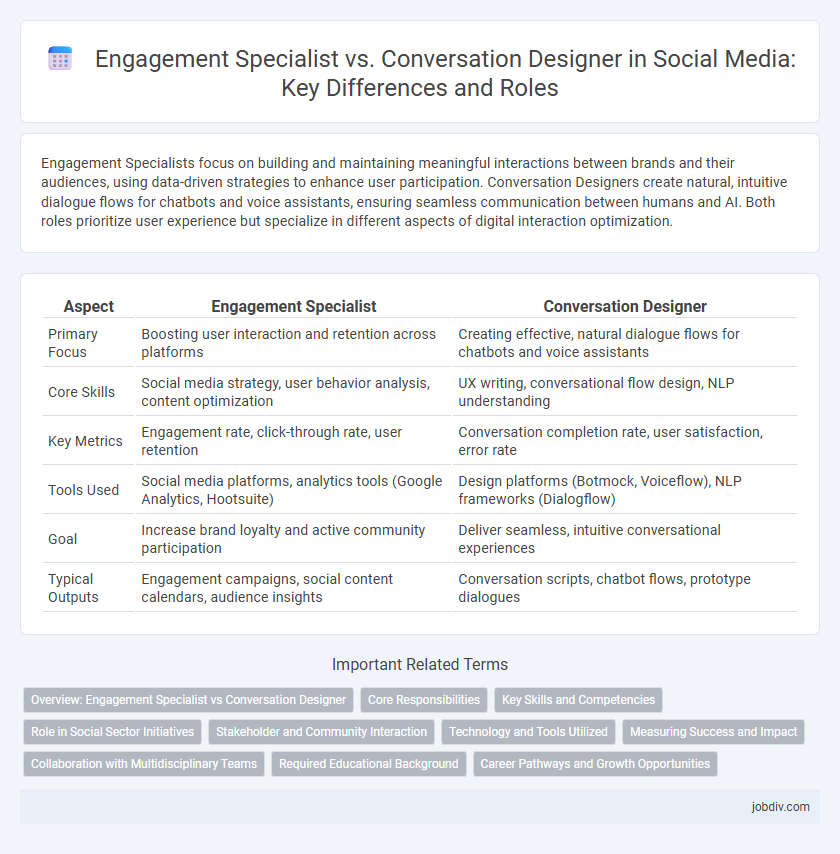Engagement Specialists focus on building and maintaining meaningful interactions between brands and their audiences, using data-driven strategies to enhance user participation. Conversation Designers create natural, intuitive dialogue flows for chatbots and voice assistants, ensuring seamless communication between humans and AI. Both roles prioritize user experience but specialize in different aspects of digital interaction optimization.
Table of Comparison
| Aspect | Engagement Specialist | Conversation Designer |
|---|---|---|
| Primary Focus | Boosting user interaction and retention across platforms | Creating effective, natural dialogue flows for chatbots and voice assistants |
| Core Skills | Social media strategy, user behavior analysis, content optimization | UX writing, conversational flow design, NLP understanding |
| Key Metrics | Engagement rate, click-through rate, user retention | Conversation completion rate, user satisfaction, error rate |
| Tools Used | Social media platforms, analytics tools (Google Analytics, Hootsuite) | Design platforms (Botmock, Voiceflow), NLP frameworks (Dialogflow) |
| Goal | Increase brand loyalty and active community participation | Deliver seamless, intuitive conversational experiences |
| Typical Outputs | Engagement campaigns, social content calendars, audience insights | Conversation scripts, chatbot flows, prototype dialogues |
Overview: Engagement Specialist vs Conversation Designer
Engagement Specialists focus on creating strategies to boost user interaction and maintain long-term relationships across social platforms, utilizing data analytics to tailor personalized experiences. Conversation Designers specialize in crafting natural, intuitive dialogue flows for AI chatbots and voice assistants, ensuring seamless human-computer interaction through linguistic and behavioral insights. Both roles aim to enhance user satisfaction but differ in their core expertise: engagement strategy versus conversational technology design.
Core Responsibilities
Engagement Specialists concentrate on building and maintaining meaningful interactions with customers by analyzing user behavior and tailoring communication strategies to increase brand loyalty and satisfaction. Conversation Designers focus on creating intuitive dialogue flows and scripting natural language interactions for chatbots and virtual assistants to enhance user experience and streamline communication. Both roles require a deep understanding of audience psychology and communication platforms but differ in applying this knowledge to either direct human engagement or AI-driven conversational interfaces.
Key Skills and Competencies
Engagement Specialists excel in customer relationship management, social media strategy, and audience analytics, driving user participation through tailored content and community-building initiatives. Conversation Designers specialize in crafting intuitive dialogue flows, natural language processing, and human-centered AI interactions, enhancing chatbot and voice assistant user experiences. Both roles require strong communication skills and empathy but differ in technical proficiency, with Engagement Specialists focusing on engagement metrics and social platforms, while Conversation Designers emphasize conversational UX design and linguistic modeling.
Role in Social Sector Initiatives
Engagement Specialists drive active participation and foster community involvement in social sector initiatives by creating targeted campaigns that amplify stakeholder voices and build trust. Conversation Designers develop AI-driven dialogue systems to facilitate seamless, empathetic interactions between organizations and beneficiaries, enhancing communication efficiency. Both roles synergize to elevate social impact through strategic human-centric engagement and technology-enabled conversations.
Stakeholder and Community Interaction
An Engagement Specialist actively fosters meaningful connections with stakeholders and community members by using targeted communication strategies to boost participation and loyalty. A Conversation Designer crafts intuitive dialogue flows and interaction models that enhance user experience and facilitate natural, efficient exchanges between brand and audience. Both roles prioritize stakeholder insight, but the Engagement Specialist emphasizes community rapport while the Conversation Designer focuses on optimizing conversational interfaces.
Technology and Tools Utilized
Engagement Specialists leverage customer relationship management (CRM) platforms, social media analytics, and marketing automation tools to enhance user interaction and drive retention. Conversation Designers employ natural language processing (NLP) frameworks, chatbot development environments such as Dialogflow or Rasa, and voice user interface (VUI) design tools to craft seamless, AI-driven communication experiences. Both roles integrate data analytics software to refine strategies and optimize user engagement across digital channels.
Measuring Success and Impact
Engagement Specialists measure success through key performance indicators like user retention, click-through rates, and community growth metrics to evaluate the effectiveness of interactive campaigns. Conversation Designers assess impact by analyzing conversational flow efficiency, user satisfaction scores, and dialogue completion rates to optimize chatbot or voice assistant experiences. Both roles utilize data-driven insights and A/B testing to continuously refine strategies for improving user engagement and interaction quality.
Collaboration with Multidisciplinary Teams
Engagement Specialists foster strong connections by aligning marketing strategies with customer behavior insights, working closely with data analysts and content creators to optimize campaign effectiveness. Conversation Designers collaborate with UX researchers, software developers, and linguists to craft intuitive, natural language interactions that enhance user experiences across digital platforms. Both roles require seamless teamwork across diverse disciplines to drive customer engagement and satisfaction through tailored communication approaches.
Required Educational Background
Engagement Specialists typically require a background in marketing, communications, or social sciences, often holding degrees in these fields to understand audience behavior and strategy development effectively. Conversation Designers usually need education in linguistics, human-computer interaction, or computer science, focusing on language structure and AI interaction to create seamless user experiences. Both roles benefit from interdisciplinary skills but emphasize distinct educational foundations aligned with their specialized tasks in social engagement and conversational interfaces.
Career Pathways and Growth Opportunities
Engagement Specialists focus on building strong customer relationships through strategic communication and personalized interactions, often advancing into roles like Customer Experience Manager or Social Media Strategist. Conversation Designers specialize in creating intuitive, AI-driven dialogue systems for chatbots and voice assistants, leading to career growth as UX Designers or AI Interaction Specialists. Both fields offer robust growth opportunities, with engagement roles emphasizing human-centered skills and conversation design requiring technical expertise in natural language processing and user experience.
Engagement Specialist vs Conversation Designer Infographic

 jobdiv.com
jobdiv.com